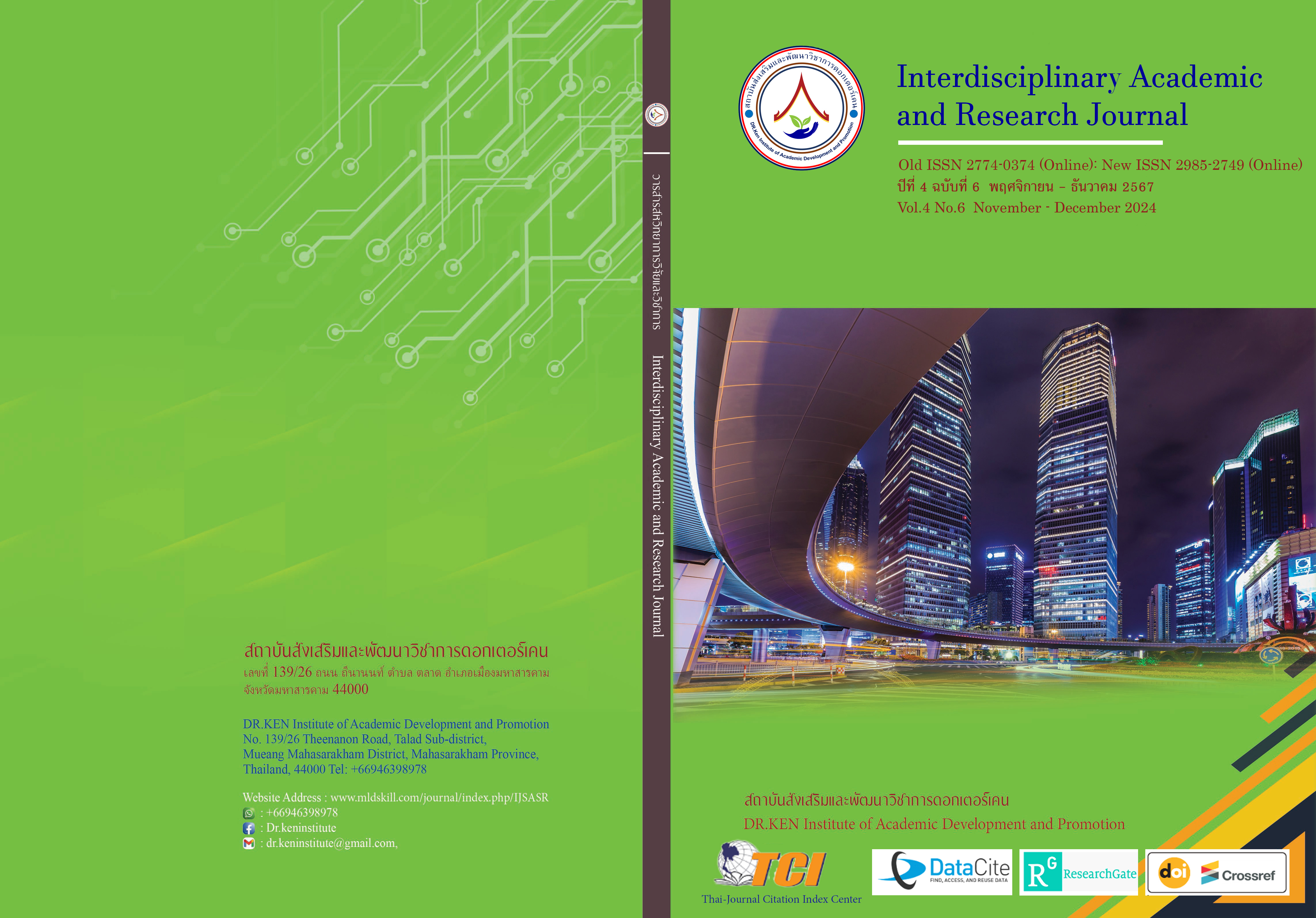The Development of Students’ Higher-Order Thinking Competencies in Problem-Solving Mathematics Classrooms through an Open Approach
DOI:
https://doi.org/10.60027/iarj.2024.278543Keywords:
Mathematical Thinking, Higher-Order Thinking, Mathematical Problem SolvingAbstract
Background and Aims: The development of students’ higher-order thinking competencies. It is absolutely essential to the nation’s progress. Particularly in the context of elementary education, which forms the core of human resource development. The objective of this research was to develop the students’ higher-order thinking competencies in mathematics classrooms that emphasize problem-solving approaches through an open approach.
Methodology: The target group was 42 of the first-grade students from two schools in Phuket province. Ethnographic research was used as the qualitative methodology. Data were gathered in the Thailand Lesson Study incorporated with an Open Approach (TLSOA) setting during the first semester of, the 2023 academic year. Data were protocol, post-lesson notes, images, and students’ worksheets comprise the data. Protocol and descriptive analysis were used to assess the data, which were then divided into two categories: 1) the student’s mathematical ideas were examined, and 2) the progression of the ideas from the students’ mathematical ideas to mathematical thinking was examined.
Results: The result revealed that students’ mathematical ideas included ideas of sets, ideas of representation, the idea of operation, the idea of algorithms, and the idea of expression. In addition, an examination of the students’ thought processes on their ideas revealed that they were aware of their ideas and summarized these ideas to learn how to learn together.
Conclusion: Students’ higher-order thinking competencies were improved through teaching through problem-solving by Open Approach, they could solved the problems by themselves. Moreover, they aware of their ideas through discussion and comparison with others, and synthesize them into learning how to learn.
References
กมลพร ทองธิยะ และกิตติชัย สุธาสิโนบล. (2564). การพัฒนาการคิดขั้นสูง: ความสามารถทางสติปัญญาที่สำคัญในโลกยุค New Normal. วารสารศึกษาศาสตร์ มหาวิทยาลัยศิลปากร. 19(2), 28-44.
กิตติศักดิ์ ใจอ่อน และกตัญญุตา บางโท. (2562). การคิดทางคณิตศาสตร์ของนักเรียน เรื่องพื้นที่ โดยใช้นวัตกรรมการศึกษาชั้นเรียนและวิธีการแบบเปิด. วารสารศึกษาศาสตร์ มหาวิทยาลัยสงขลานครินทร์ วิทยาเขตปัตตานี. 31(1), 28-37.
พิมพ์ผกา อินทะรส, ชนิกา เสนาวงค์ษา และสรินยา ไชยวงศ์. (2564). การเรียนรู้เครื่องมือในการเรียนรู้ของนักเรียนในตารางการคูณของ 2 ถึง 5. ใน ไมตรี อินทร์ประสิทธิ์ (บ.ก.), 2 ทศวรรษของการปฏิรูปกระบวนการเรียนรู้สู่สมรรถนะการคิดขั้นสูง. การประชุมวิชาการระดับชาติด้านคณิตศาสตรศึกษา ครั้งที่ 7 (น. 106). สมาคมคณิตศาสตรศึกษา.
ไมตรี อินทร์ประสิทธิ์. (2546). การปฏิรูปกระบวนการเรียนรู้วิชาคณิตศาสตร์ในโรงเรียนโดยเน้นกระบวนการทางคณิตศาสตร์. ขอนแก่น: ขอนแก่นการพิมพ์.
ไมตรี อินทร์ประสิทธิ์. (2557). กระบวนการแก้ปัญหาในคณิตศาสตร์ระดับโรงเรียน. พิมพ์ครั้งที่ 1. ขอนแก่น: บริษัท เพ็ญพรินติ้ง จำกัด.
ไมตรี อินทร์ประสิทธิ์. (2562). คณิตศาสตร์สำหรับระดับประถมศึกษา ชั้นประถมศึกษาปีที่ 1. พิมพ์ครั้งที่ 2. ขอนแก่น: ศูนย์วิจัยคณิตศาสตรศึกษา คณะศึกษาศาสตร์ มหาวิทยาลัยขอนแก่น.
ไมตรี อินทร์ประสิทธิ์. (2565). กระบวนการแก้ปัญหาในคณิตศาสตร์ระดับโรงเรียน. พิมพ์ครั้งที่ 2. ขอนแก่น: ไอ-ปริ้นท์ ดีไซน์ จำกัด.
ไมตรี อินทร์ประสิทธิ์. (2567). การศึกษาชั้นเรียนด้วยวิธีการแบบเปิด : PLC ภาคปฏิบัติจริงในโรงเรียน ใน ไมตรี อินทร์ประสิทธิ์ (บ.ก.), การประชุมการเปิดชั้นเรียนระดับชาติ ครั้งที่ 17 (น. 47-62). สถาบันวิจัยและพัฒนาวิชาชีพครูสำหรับอาเซียน.
สำนักงานคณะกรรมการการศึกษาขั้นพื้นฐาน กระทรวงศึกษาธิการ. (2564). สมรรถนะการคิดขั้นสูง(Higher Order Thinking:HOT). Retrieved on 10 July 2023 from https://cbethailand.com/หลักสูตรฐานสมรรถนะ/สมรรถนะหลัก-5-ประการ/สมรรถนะการคิดขั้นสูง/
Collins, R. (2014). Skills for the 21st Century: Teaching Higher-Order Thinking. Curriculum & Leadership Journal. 12(14), 1-8
Hamzah, H., Hamzah, M.I., & Zulkifli, H. (2022). Systematic Literature Review on the Elements of Metacognition-Based Higher Order Thinking Skills (HOTS) Teaching and Learning Modules. Sustainability. 14(2), 1-15. https://doi.org/10.3390/su14020813 DOI: https://doi.org/10.3390/su14020813
Haryati, S., Trisnowati, E., Siswanto, S., & Al Firdaus, M.M. (2021). Identifying Higher-Order Thinking Skills on Lesson Plan: How Do Teachers Construct the Lesson Plan?. Tadris: Jurnal Keguruan dan Ilmu Tarbiyah. 6(2), 277-285. https://doi.org/10.24042/tadris.v6i2.8828 DOI: https://doi.org/10.24042/tadris.v6i2.8828
Inprasitha, M. (2022). Lesson study and open approach development in Thailand: a longitudinal study. International Journal for Lesson and Learning Studies. 11(5), 1-15. https://doi.org/10.1108/IJLLS-04-2021-0029 DOI: https://doi.org/10.1108/IJLLS-04-2021-0029
Isoda, M. & Katagiri, S. (2012). Mathematical Thinking how to Develop it in the Classroom. Singapore: World Scientific Publishing. DOI: https://doi.org/10.1142/8163
Lester, F.K. (1994). Musings about mathematical problem-solving research 1970-1994. Journal for Research in Mathematics Education. 25, 660-675. DOI: https://doi.org/10.5951/jresematheduc.25.6.0660
Downloads
Published
How to Cite
Issue
Section
License
Copyright (c) 2024 Interdisciplinary Academic and Research Journal

This work is licensed under a Creative Commons Attribution-NonCommercial-NoDerivatives 4.0 International License.
Copyright on any article in the Interdisciplinary Academic and Research Journal is retained by the author(s) under the under the Creative Commons Attribution-NonCommercial-NoDerivatives 4.0 International License. Permission to use text, content, images, etc. of publication. Any user to read, download, copy, distribute, print, search, or link to the full texts of articles, crawl them for indexing, pass them as data to software, or use them for any other lawful purpose. But do not use it for commercial use or with the intent to benefit any business.
















.png)


